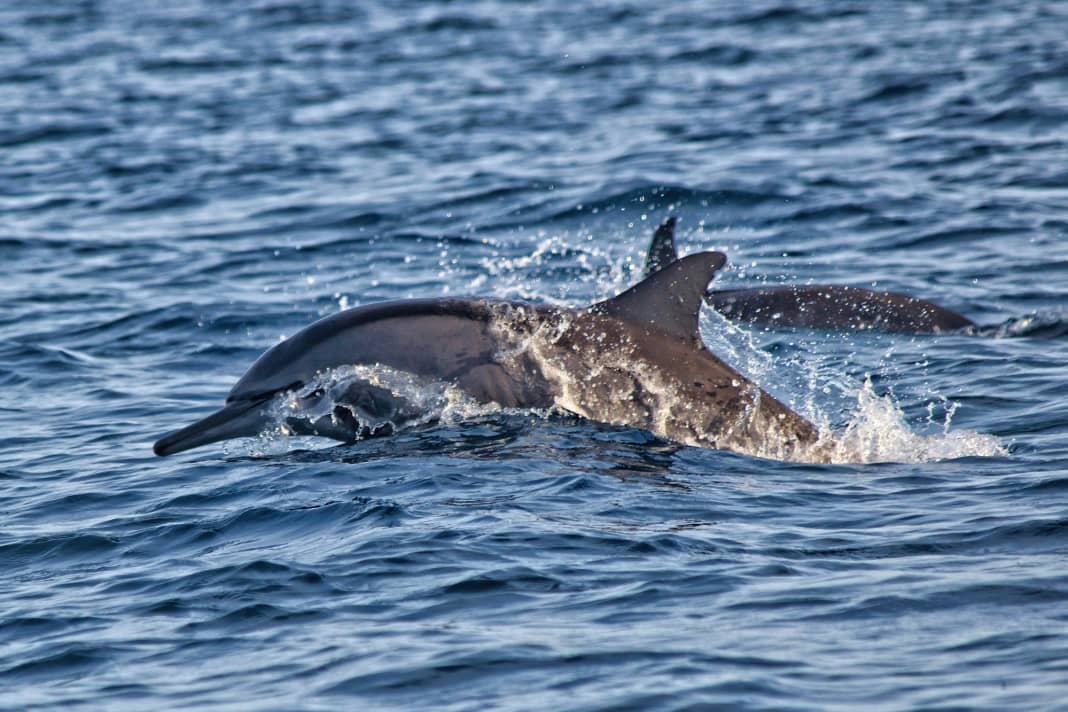





Lukas von Levern and Maximilian Reger were visited by several bottlenose dolphins during their winter training trip in Strander Bucht a few days ago. At least four animals accompanied the two sailors over a period of a quarter of an hour. Reger confirms that some of them jumped out of the water just a few centimetres from them, so that they could have been touched by hand.
The young sailor, who actually comes from Chiemsee in Bavaria but now lives at the boarding school at the federal base in Kiel, remembers: "I was both delighted and surprised and initially thought they were harbour porpoises. It was only afterwards that I realised they were dolphins, which surprised me even more."
Dolphins are not actually native to the Baltic Sea, but harbour porpoises are seen more frequently in the western Baltic Sea. Sometimes they also swim alongside sailing boats, but with a body length of around 1.50 metres, they are significantly smaller than a dolphin. Bottlenose dolphins, the most common dolphin species, reach a length of between 1.90 and 4 metres.
Shoal of herring could have lured the bottlenose dolphins into the fjord
The school of dolphins off Strande presumably followed a shoal of herring that come to spawn in the Baltic Sea from March onwards, according to Kiel whale expert Boris Culik in the Kieler Nachrichten newspaper. Even though the bottlenose dolphins are not actually at home in the Baltic Sea, individual animals have been spotted here time and again. In spring 2023, for example, "Delle" fascinated onlookers for several weeks with leaps in the harbour entrance to Travemünde. The bottlenose dolphin was no stranger to the harbour; it had previously been regularly encountered by sailors in Svendborg Sound before moving further south to Travemünde.
The two Ilca sailors were on the water without a coach when the dolphin group first appeared at Strande. Von Levern, who is currently preparing for the U21 European Championships in Pollença, Mallorca, in March, was able to film the encounter. Reger will be travelling to the Spanish island next week for training followed by the Europa Cup. Will they then also encounter dolphins on the regatta course?
Dolphins in the Baltic Sea: rare but regular visitors
In 2019, YACHT reader and skipper Fritz Plewe reported an encounter with a bottlenose dolphin that swam around his boat in the Baltic Sea for hours. Professor Boris Culik from the Geomar Helmholtz Centre for Ocean Research Kiel explained the background.
YACHT: Professor Culik, is the appearance of dolphins in the Baltic Sea really a new development? What are the causes?
Culik: In fact, there are and have always been various marine mammal species that have found their way into the Baltic Sea. This also applies to dolphins. The Danish website hvaler.dk lists current sightings. The Danish Belt Sea is the most affected. However, prominent guests such as the fin whale in the Kiel Fjord, the bottlenose dolphins Selfi and Delphi, the bottlenose dolphin Freddy and the dolphin Schwentini are also examples of this in recent years.
Are these isolated cases or are they signs of a fundamental change in the marine fauna?
So far, these are isolated cases: All the bottlenose dolphins mentioned were males, so no independent population can be established.
Earlier media reports and the video and photo material we have seen give the impression that the dolphins are looking for proximity to people or boats. Is this impression correct?
In fact, dolphins have been known to do this since ancient times. They play with the bow waves of ships and seem to seek contact. Presumably they are simply very curious. A scientific study by Terrie Williams has shown that surfing in the bow wave is for dolphins what travelling by bus is for us: effortless.
Is the change in marine fauna in the Baltic Sea against the backdrop of climate change good news or sad news?
Climate change is perhaps less important in this context than the recovery of the dolphin population in the North Sea, one of the reasons cited for the increased occurrence in the Baltic Sea. And here there are also interesting fish prey such as sprats, herring and mackerel, as well as cod, which occur in large numbers at certain times, for example during spawning, and provide plenty of food.

